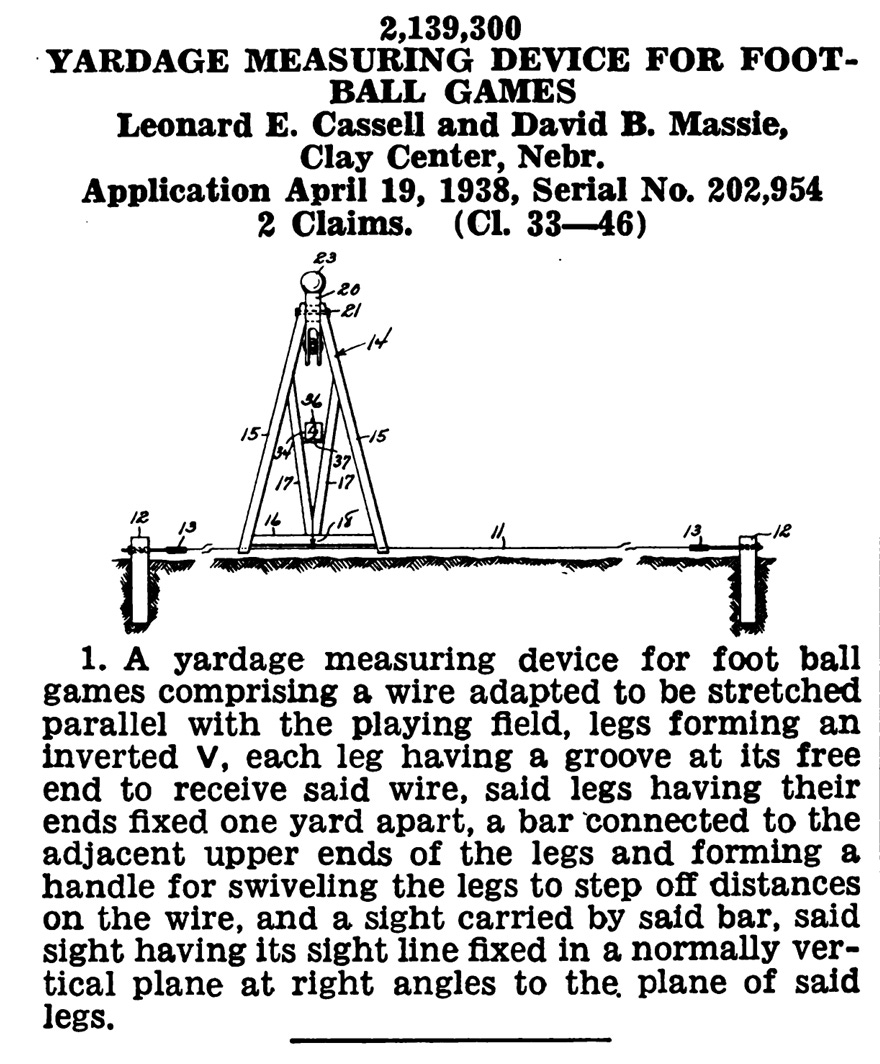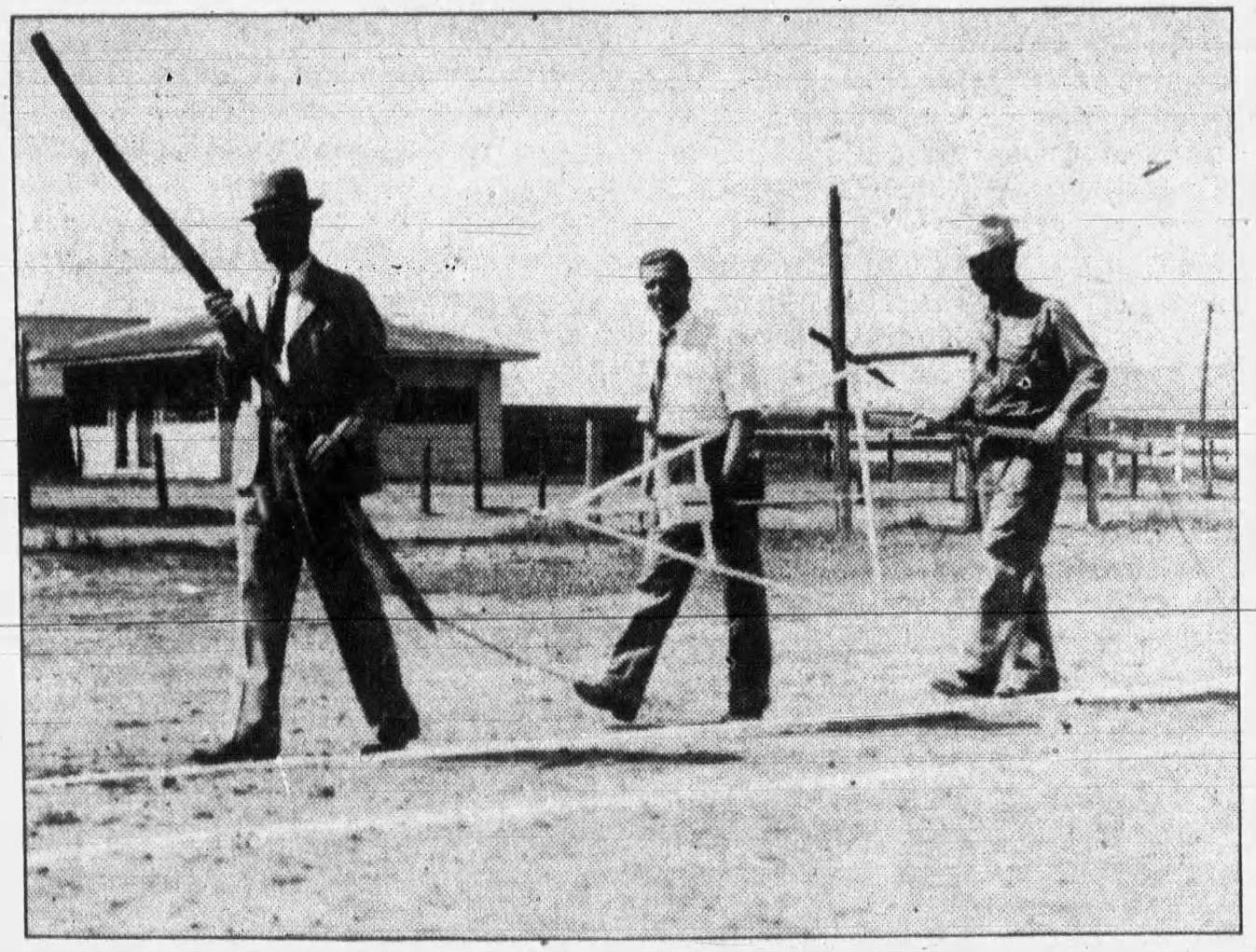Today's Tidbit... The Honest Head Linesmen
If one aspect of football has attracted the brainpower of tinkerers more than any other, it is the down box and chains. Down boxes, especially, are the backdoor light of tinkerers who are unwilling to give an inch.
Eyeballing where to place the down box and the sticks with ten yards of chain passing between them has always been a bit backward. Still, dozens of inventors, many of whom received patents, have found a way to improve football's measurement process, only to be ignored by officiating crews and the public.
An example down box I found recently on the scene in 1938 when L. E. "Bum" Cassell and D. B. "Ben" Massie of Clay Center, Nebraska, earned patent #2,139,300 for a yardage measuring device for football games.

Cassell, who ran a filling station in Clay Center, watched a high school game in 1937 after a group of freshmen mismarked the field. Unable to draw yard lines that remained perpendicular to one another, Cassell was frustrated by the markings and the officials' reliance on them. Convinced he could reinvent the down box and win widespread acclaim, Cassell created an accurate and relatively simple device.
Here's what he came up with. Cassell had a strand of taut wire anchored at the goal lines or end line that rested just off the sideline, with each yard line marked on the wire. Sliding along the wire was an A-frame device with legs one yard apart. Midway up the A-frame were numbers designating the down for the officials, and near the top was a sight with a vertical crosshair. That meant the assistant lineman lined up the crosshair with the front of the ball to mark the spot accurately.
Since the wire ran perpendicular to the field and the A-frame was attached to the line, it was also perpendicular to the field. So, the assistant lineman could line up the crosshair with the front of the ball to accurately mark the first down spot, and the line to gain was automatically marked ten yards downfield. Determining whether a team had made a first down was as easy as looking through the sight to see whether the ball was short of the crosshair. Crews would not longer need to drag the chains onto the field, and the referee could more quickly return the ball to the correct spot following an incompletion or an out-of-bounds play. (Marking the ball correctly was much more challenging before the mid-1950s and the onset of Lockney Lines.)

Cassell named his device the "Honest Head Linesman," which likely did not endear him to the officiating set, but he convinced a handful of coaches and officials to give the device a go. They used it for a Hastings-Morningside game and then for a Chadron-Kearney game, and it was the latter game that might have been the device's downfall.
Everyone agreed to its use, and the officials decided to trust the device and not bring the chains onto the field for measurements. Unfortunately, they did not confirm that decision with the coaches, so when Chadron took the ball to the Kearney 7-yard line on a fourth down play, they asked for a measurement, despite the Honest Head Linesman showing they were short of the line to gain.
After a 15-minute argument, the officials gave in, and the chain gang stepped onto the field and checked things out the old-fashioned way, which showed Chadron had earned the first down. While the Honest Head Linesman likely was the more accurate of the two measurements, it did not matter as the tool had been proven faulty, at least to Chadron fans.
Remarks about Cassell's invention popped up a few more times that year as folks tested the device in several parts of the country, but it disappeared after the 1938 season, never to be heard from again. Other new and improved inventions popped up occasionally, but none replaced the eyeballing process used since the Crescent Athletic Club introduced chains in 1894.
Football Archaeology is reader-supported. Click here to buy one of my books or otherwise support the site.



Every official who has ever worked “the flanks” should surely enjoy this read! Great work, Tim!
As a former official who had worked on a bunch of poorly marked grass fields, I can say we were always looking for better ways. However I would think the tight wire from end line to end line would be a safety tripping hazard in the modern game that has mass substitution. I like the way the guy is thinking, but boo! to his choice of names for the device!